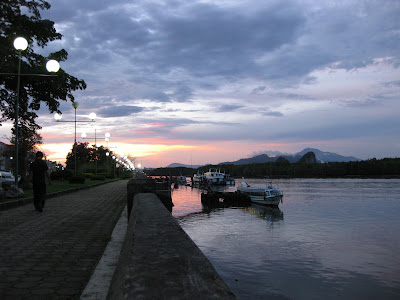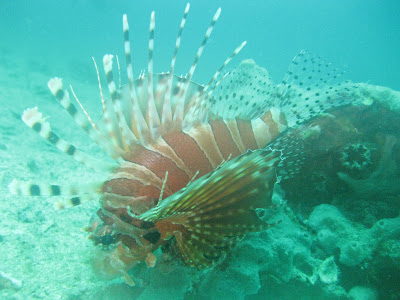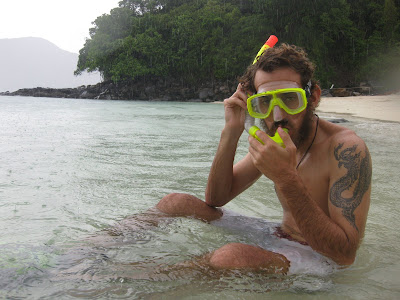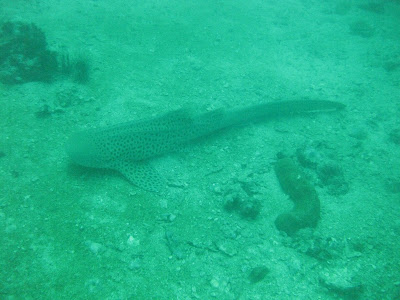Thailand. There are two very distinct worlds that exist side by side in this Southeast Asian country--the tourist world and the local. Thailand has a long history of tourism and is well equipped to accommodate its foreign guests. Our visit to Southern Thailand brought us primarily in contact with the tourist world. With all the British/Aussie beer guzzling gap year students to the bachelor party contingencies, we felt a little out of our element. (Gap year students pictured above.) We didn't care though....we came to dive. Our guide book was written just months after the Tsunami (Dec 2004) and described Ko Phi Phi island (our destination) as a devastated community trying to rebuild itself. Apparently they have succeeded. We arrived to find Ko Phi Phi alive with nightclubs, packed with guesthouse bungalows and supporting over 14 dive centers. Although we were happy to see that the island had recuperated from the disaster, the development free-for-all has left a huge scar across the face of this island's stunning natural beauty. In the rush to capitalize on the tourist trade, developers are destroying, and arguably have already destroyed any remnants of indigenous culture. Also, the booming sound systems and beach front bars completely prevent you from enjoying the natural surroundings of the area. Every accessible piece of coastline has been staked out by a bar or a resort. It was disgusting to see such a unique and gorgeous area being devoted to activities that could just as easily take place inside a warehouse in Patterson, New Jersey. However, you can't have a euro trash bar on the bottom of the ocean, so we were super stoked to go diving. On the boat and under water, it was a completely different experience that we loved. Enter Thailand....
Well, of course we had to get there first. We left Malaysia in the middle of the night and crossed over to the border town of Hat Yai. There we grabbed this mini van who is seen here picking up another "passenger," the outer body of a Honda Accord. This is the Southeast Asia we knew and loved.We arrived in Krabi, a main launching point for the dramatic islands of the Andaman coast. Max was here back in '05 and highly recommends it as a rock climbing destination. Anxious to dive, we only stayed here for the night.
Here we are on super speed boat to Ko Phi Phi. Pronounced "pee-pee." We were surrounded by a massive group of gap-year students on this boat, sun tanning, smoking, and drinking beer at 9am. We guess that's what the British call "pre-gaming." Damn, England. You have a serious drinking problem. Kara was stoked to be in a tank top without a cover up after being in predominately Islamic Malaysia and Indonesia for the last couple of months. We were listening to Daft Punk's live album and Girl Talk for the duration of the ride. For some reason techno music and tropical sea-scapes work well together. At least on the speed boat.

Another street scene. Drunk dudes considering tattoo designs. We were pleased that at least one of these dudes had the foresight to proclaim himself too drunk to get permanent body art. We salute you, drunk dude. Meanwhile, we had dropped off our bags and signed up for our dives. Our plan was to get in and get out. Realizing that there's nothing wrong with having a good time, we got off our high horses and attempted to do so that night.
An Iranian-Swedish sibling couple invited us to meet them at this bar, "Carpe Diem" for a fire show and a couple drinks on the beach. Naturally. Why not, we should have fun! The fire show was sloppy, but spirited, as were the drinks.


This was our first official deep dive with a maximum depth of 30 meters. We had gone to this depth before in Indonesia, but this time we have the paperwork to prove it. It was also our first wreck dive, which was interesting but we are more into reefs. This is a ferry that used to transport cargo and vehicles from Phuket to Ko Phi Phi and is rumored to have been purposefully sunk by its captain for the insurance money. In the end, the government charged the boat captain for the relocation of the wreck which was crushing the coral reef. The whole thing sounds like a Thai morality tale.
Arriving on Ko Phi Phi.
More arriving on Ko Phi Phi. As soon as we stepped off the pier, we were accosted by the beer/chachkie/Thai pancake bazaar that IS the island. We had immediate thoughts about getting right back on the boat to Krabi, but decided to give the island the benefit of the doubt. 
Another street scene. Drunk dudes considering tattoo designs. We were pleased that at least one of these dudes had the foresight to proclaim himself too drunk to get permanent body art. We salute you, drunk dude. Meanwhile, we had dropped off our bags and signed up for our dives. Our plan was to get in and get out. Realizing that there's nothing wrong with having a good time, we got off our high horses and attempted to do so that night.

An Iranian-Swedish sibling couple invited us to meet them at this bar, "Carpe Diem" for a fire show and a couple drinks on the beach. Naturally. Why not, we should have fun! The fire show was sloppy, but spirited, as were the drinks.
Yep, that's Max, drinking a BUCKET of alcohol. Kara's bucket photos have been censored from this blog. Never again, buckets. Never again... well at least not two in one night. Alcohol is pretty much exclusively sold in buckets on the island, much like the ones you would use to build a sandcastle as a child.
We realized half way in that drinking before diving the next day might be a bad idea, especially after being completely sober for months. However, the music was good, and yeah, we had a good time.

Until the morning. We don't think this picture needs further explanation. For some reason Kara was fine the next day. Max however, puked in his regulator. Maximilian: "If you find yourself in this stupid situation, which you should take all lengths to avoid, do not panic, vomit as per usual and give a strong exhalation. Everything will be fine."
They were beautiful dives. Fish everywhere.

This was our first official deep dive with a maximum depth of 30 meters. We had gone to this depth before in Indonesia, but this time we have the paperwork to prove it. It was also our first wreck dive, which was interesting but we are more into reefs. This is a ferry that used to transport cargo and vehicles from Phuket to Ko Phi Phi and is rumored to have been purposefully sunk by its captain for the insurance money. In the end, the government charged the boat captain for the relocation of the wreck which was crushing the coral reef. The whole thing sounds like a Thai morality tale.
Beautiful soft coral.
Again, Max not doing so well on the boat. Max describes his current mental and physical state after the first dive. There are some Europeans in the back.
Going in to the water for another dive. Emerald limestone karsts emerge suddenly from the clear water. These unique limestone formations are the signature physical feature of the Andaman coast of Thailand. Remember Dr. No's lair? That was in one of these guys.
Fishes.
Nemos.
Moray eel.

Back on the island, oof. Bamboo tattoos parlors are everywhere.

Max feels better and jumps off the boat.
Lion fish.
Many fish.
Puffer Fish. The puffer fish blows himself up as a defensive mechanism and can only do it a couple of times in its life before the stress of this action takes a toll on its heart. So it is important not to wantonly scare the puffer fish for your own personal satisfaction. He looks puffy as it is.
As you can see, the novelty of taking photos underwater has not worn off yet. Kara loves taking pictures of Max so much and it translates even underwater. Max is happy amongst the fishes.
Everyone ok. That's what the ballerina gesture signifies to the boat after ascending to the surface. Pick us up, boat!

Back on the island, oof. Bamboo tattoos parlors are everywhere.

Sandwich Burger Pancake.

The next day we decided to chill out and decompress. Literally. Nothing like a little Ayn Rand to loosen the nerves.

The next day we decided to chill out and decompress. Literally. Nothing like a little Ayn Rand to loosen the nerves.
We rented some snorkeling gear and walked out as far away from the bar front madness as possible.

The omnipresent King of Thailand. More on him later.


The omnipresent King of Thailand. More on him later.
As we continued to walk to our snorkeling spot, we realized that the rainy season was upon us. AGAIN. We are following it throughout Southeast Asia.
Cold Kara Fox.Juvenile Harlequin clown fish. This fish grows up to look completely different, changing color and body shape dramatically.

The next day it didn't rain. That was nice. Here is The Beach. That's right, capitalised. As in Leonardo Dicaprio, bohemian backpacker paradise, released in the year 2000 The Beach. The island (Ko Phi Phi Lay) is an hour boat ride away from Ko Phi Phi Don. You can camp here for the night but the island is a nature reserve and permanent dwellings are prohibited. The movie itself is shown every night in at least one bar on Ko Phi Phi. It is ironic to see people glued to a projection screen depicting Leonardo's escape from the very tourist infested party culture in which they are immersed.


Diving near Ko Phi Phi Lay. This is a cuddle fish and he changes colors. He's really big. Like the size of Kara or Max's torso depending on the fish. Both Kara and Max have sizeable torsos.








































































